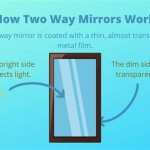What Kind of Mirror is Used in Car Headlights?
Car headlights play a crucial role in ensuring driver safety, especially during nighttime driving. The ability of headlights to illuminate the road ahead depends heavily on the type of mirror used within the headlight assembly. While the concept of a mirror might seem simple, the specific type of mirror employed in car headlights is carefully chosen to optimize light distribution and ensure proper illumination. This article explores the type of mirror used in car headlights, delving into its design and purpose.
Parabolic Reflectors: The Foundation of Headlight Illumination
The primary type of mirror used in car headlights is a parabolic reflector. This design is based on the principle of parabolic geometry, where a parabola is a curve generated by a point that moves so that it is always the same distance from a fixed point (the focus) and a fixed line (the directrix). This geometric property is crucial for the functionality of car headlights.
In a parabolic reflector, the light source, usually a halogen bulb, LED, or HID lamp, is positioned at the focus of the parabola. When light rays emanate from the bulb, they strike the parabolic surface and are reflected in a parallel manner. This parallel beam of light ensures that the headlights illuminate the road ahead in a straight, focused manner, maximizing visibility and allowing the driver to see clearly.
The Role of the Reflector in Light Distribution
Beyond simply reflecting light, the parabolic reflector plays a vital role in controlling the distribution of light. Different types of headlights, such as low beams and high beams, utilize slight variations in the parabolic reflector to achieve distinct illumination patterns designed for different driving scenarios.
For instance, low beams are designed to illuminate the road directly ahead while minimizing glare for oncoming drivers. This is achieved with a slightly flattened parabolic reflector, which directs the light beam downwards. High beams, on the other hand, are designed to provide maximum illumination for longer distances. They typically use a deeper parabolic reflector that focuses the light beam higher and further ahead, allowing the driver to see objects further away.
Advantages of Parabolic Reflectors
The use of parabolic reflectors in car headlights offers several advantages:
-
Efficient Light Distribution
: The parallel beam of light produced by parabolic reflectors ensures that light is distributed evenly, maximizing visibility and minimizing light wastage. -
Improved Visibility
: By focusing the light beam, parabolic reflectors enhance the driver's ability to see objects clearly, especially at night or in low-light conditions. -
Reduced Glare
: Compared to traditional flat reflectors, parabolic reflectors minimize glare for oncoming drivers, promoting driving safety. -
Cost-Effectiveness
: Parabolic reflectors are relatively inexpensive to manufacture, making them a practical and economical option for car headlights.
Which Mirror Is Used In The Headlight Of A Car Quora

Which Type Of Mirror Is Used In Headlights Vehicles

Car Headlights
Flashlights And Car Headlights All Have Concave Mirrors Why Would It Not Be A Good Idea To Use Convex Mirror Instead Quora

State The Type Of Mirrors Used For I Headlights And Ii Rearview In Cars Motorcycles Give Reason To Justify Your Answer Each Case

Which Mirror Is Used In The Headlights Of A Car

Why Headlights Used Concave Mirror

Concave Vs Convex Mirrors In Cars

Concave Vs Convex Mirrors In Cars
Why Do We Use A Concave Mirror In Car Headlights Quora








